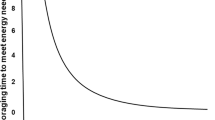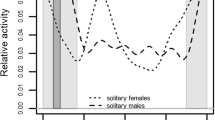Summary
The relative importance of food a vailability and intruder pressure on breeding territorial behavior was studied in two experiments with male calliope hummingbirds. In the first experiment, extra food was provided in inconspicuous feeders. Territory owners who fed from the feeders increased their display rates (power-diving and hovering) when on their territories, and spent less time out of sight (mostly off their territories). Food addition by this method had no significant effect on intruder pressure, as measured by number and duration of chases. In the second experiment, intruder pressure was increased by attracting feedertrained males to feeders in territories of individuals who did not feed from feeders. In this experiment, display activity of residents did not change but chasing activity increased. These results suggest that display rates by male calliope hummingbirds depend at least in part on the amount of food available, but are not strongly affected by the number of feeding attempts by male intruders. No attempt was made to determine whether displays can deter competitors, attract mates, or do both. However, since these energetically expensive displays depend at least in part on the energy available to owners, they provide readily available indices of male and/or territory quality which could potentially be used for different purposes by different individuals.
Similar content being viewed by others
References
Bent AC (1940) Life histories of North American cuckoos, goatsuckers, hummingbirds and their allies. US Natl Mus Bull 176:1–506
Calder WA (1971) Temperature relationships and nesting of the calliope hummingbird. Condor 73:314–321
Ewald PW, Carpenter FL (1978) Territorial responses to energy manipulations in the Anna hummingbird. Oecologia (Berl) 31:277–292
Ewald PW, Orians GH (1983) Effects of resource depression on use of inexpensive and escalated aggressive behavior: experimental tests using Anna hummingbirds. Behav Ecol Sociobiol 12:95–101
Ewald PW, Rohwer S (1980) Age, coloration and dominance in nonbreeding hummingbirds: a test of the asymmetry hypothesis. Behav Ecol Sociobiol 7:273–279
Ewald PW, Hunt GL Jr, Warner M (1980) Territory size in Western gulls: importance of intrusion pressure, defence investments, and vegetation structure. Ecology 61:80–87
Gass CL (1978) Rufous hummingbird feeding territoriality in a suboptimal habitat. Can J Zool 56:1535–1539
Gass CL, Montgomerie RD (1981) Hummingbird foraging behavior: decision-making and energy regulation. In: Kamil AC, Sargent TD (eds) Foraging behavior: ecological, ethological, and psychological approaches. Garland, New York, pp 159–194
Miller SJ, Inouye DW (1983) Roles of the wing whistle in the territorial behaviour of male broad-tailed hummingbirds (Selasphorus platycercus). Anim Behav 31:689–700
Myers JP, Connors PG, Pitelka FA (1979) Territory size in wintering sanderlings: the effects of prey abundance and intruder density. Auk 96:551–561
Myers JP, Connors PG, Pitelka FA (1981) Optimal territory size and the sanderling: compromises in a variable environment. In: Kamil AC, Sargent TD (eds) Foraging behavior: ecological, ethological, and psychological approaches. Garland, New York, pp 135–158
Norton ME, Arcese P, Ewald PW (1982) Effects of intrusion pressure on territory size in black-chinned hummingbirds (Archllochus alexandri). Auk 99:761–764
Pitelka FA (1942) Territoriality and related problems in North American hummingbirds. Condor 44:189–204
Searcy WA (1979) Sexual selection and body size in male redwinged blackbirds. Evolution 33:649–661
Snow BK (1973) Social organization of the hairy hermit Glaucis hirsuta. Ardea 61:94–105
Stiles FG (1973) Food supply and the annual cycle of the Anna hummingbird. Univ Calif Publ Zool 97:1–109
Stiles FG (1982) Aggressive and courtship displays of the male Annas hummingbird. Condor 84:208–225
Stiles FG, Wolf LL (1979) Ecology and evolution of lek mating behavior in the long-tailed hermit hummingbird. AOU Ornitol Monogr 27
Wilhelm K, Comtesse H, Pflumm W (1982) Einfluss der Konzentration der Zuckerlösung auf den Gesang und das Balzverhalten des Gelbbauchnektarvogels (Nectarinia venusta). Z Tierpsychol 60:27–40
Wolf LL (1975) “Prostitution” behavior in a tropical hummingbird. Condor 77:140–144
Wolf LL, Stiles FG (1970) Evolution of pair cooperation in a tropical hummingbird. Evolution 24:759–773
Woods RS (1924) Some birds of the San Gabriel Wash. Bird-Lore 26:1–9
Woods RS (1927) The hummingbirds of California. Auk 44:297–318
Ydenberg RC (1984) The conflict between feeding and territorial defence in the great tit. Behav Ecol Sociobiol 15:103–108
Author information
Authors and Affiliations
Rights and permissions
About this article
Cite this article
Tamm, S. Breeding territory quality and agonistic behavior: effects of energy availability and intruder pressure in hummingbirds. Behav Ecol Sociobiol 16, 203–207 (1985). https://doi.org/10.1007/BF00310982
Received:
Accepted:
Issue Date:
DOI: https://doi.org/10.1007/BF00310982




